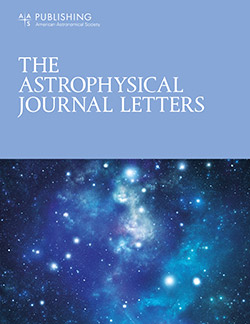The Origin of Power-law Spectra in Relativistic Magnetic Reconnection
IF 8.8
1区 物理与天体物理
Q1 ASTRONOMY & ASTROPHYSICS
引用次数: 1
Abstract
Abstract Magnetic reconnection is often invoked as a source of high-energy particles, and in relativistic astrophysical systems it is regarded as a prime candidate for powering fast and bright flares. We present a novel analytical model—supported and benchmarked with large-scale three-dimensional kinetic particle-in-cell simulations in electron–positron plasmas—that elucidates the physics governing the generation of power-law energy spectra in relativistic reconnection. Particles with Lorentz factor γ ≳ 3 σ (here, σ is the magnetization) gain most of their energy in the inflow region, while meandering between the two sides of the reconnection layer. Their acceleration time is相对论性磁重联中幂律谱的起源
磁重联通常被认为是高能粒子的来源,在相对论天体物理系统中,它被认为是驱动快速明亮耀斑的主要候选者。我们提出了一种新的分析模型,以电子-正电子等离子体中大规模三维动力学粒子在细胞内的模拟为基准,阐明了相对论重连中幂律能谱产生的物理规律。具有洛伦兹因子γ≥3 σ (σ为磁化强度)的粒子在流入区获得大部分能量,而在重联层的两侧之间徘徊。它们的加速时间为t acc ~ γ η rec−1 ω c−1≃20 γ ω c−1,其中η rec≈0.06为以光速为单位的流入速度,ω c = eB 0 / mc为上游磁场的陀螺频率。当它们被重新连接的等离子体的一条流出的通量绳捕获时,它们离开了主动通电区域。在我们的模拟中,我们直接测量了t esc,并发现t esc ~ t acc对于σ < 0。这导致了一个普遍的(即σ无关的)幂律谱dN free / d γ∝γ−1对于经历主动加速的粒子,和dN / d γ∝γ−2对于整个粒子群。我们的结果有助于阐明在天体物理非热源中普遍存在的幂律粒子和光子光谱。
本文章由计算机程序翻译,如有差异,请以英文原文为准。
求助全文
约1分钟内获得全文
求助全文
来源期刊

Astrophysical Journal Letters
ASTRONOMY & ASTROPHYSICS-
CiteScore
14.10
自引率
6.30%
发文量
513
审稿时长
2-3 weeks
期刊介绍:
The Astrophysical Journal Letters (ApJL) is widely regarded as the foremost journal for swiftly disseminating groundbreaking astronomical research. It focuses on concise reports that highlight pivotal advancements in the field of astrophysics. By prioritizing timeliness and the generation of immediate interest among researchers, ApJL showcases articles featuring novel discoveries and critical findings that have a profound effect on the scientific community. Moreover, ApJL ensures that published articles are comprehensive in their scope, presenting context that can be readily comprehensible to scientists who may not possess expertise in the specific disciplines covered.
 求助内容:
求助内容: 应助结果提醒方式:
应助结果提醒方式:


